
The Lumière brothers, Auguste Marie Louis Nicolas Lumière and Louis Jean Lumière, were French manufacturers of photography equipment, best known for their Cinématographe motion picture system and the short films they produced between 1895 and 1905, which places them among the earliest filmmakers.
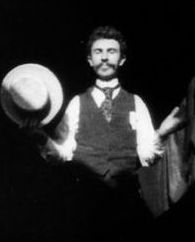
William Kennedy Laurie Dickson was a British inventor who devised an early motion picture camera under the employment of Thomas Edison.

The Kinetoscope is an early motion picture exhibition device, designed for films to be viewed by one person at a time through a peephole viewer window. The Kinetoscope was not a movie projector, but it introduced the basic approach that would become the standard for all cinematic projection before the advent of video: it created the illusion of movement by conveying a strip of perforated film bearing sequential images over a light source with a high-speed shutter. First described in conceptual terms by U.S. inventor Thomas Edison in 1888, it was largely developed by his employee William Kennedy Laurie Dickson between 1889 and 1892. Dickson and his team at the Edison lab in New Jersey also devised the Kinetograph, an innovative motion picture camera with rapid intermittent, or stop-and-go, film movement, to photograph movies for in-house experiments and, eventually, commercial Kinetoscope presentations.
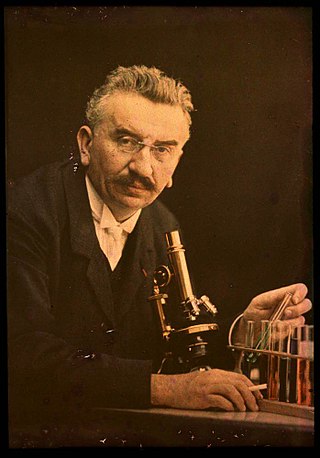
Louis Jean Lumière was a French engineer and industrialist who played a key role in the development of photography and cinema.

A movie projector is an opto-mechanical device for displaying motion picture film by projecting it onto a screen. Most of the optical and mechanical elements, except for the illumination and sound devices, are present in movie cameras. Modern movie projectors are specially built video projectors.
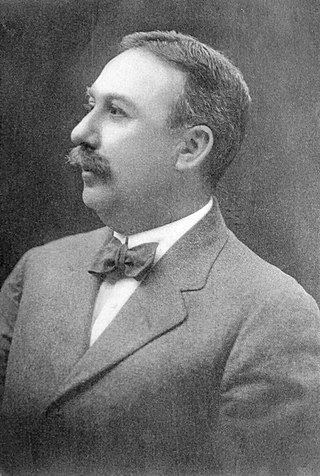
Edwin Stanton Porter was an American film pioneer, most famous as a producer, director, studio manager and cinematographer with the Edison Manufacturing Company and the Famous Players Film Company. Of over 250 films created by Porter, his most important include What Happened on Twenty-third Street, New York City (1901), Jack and the Beanstalk (1902), Life of an American Fireman (1903), The Great Train Robbery (1903), The European Rest Cure (1904), The Kleptomaniac (1905), Life of a Cowboy (1906), Rescued from an Eagle's Nest (1908), and The Prisoner of Zenda (1913).
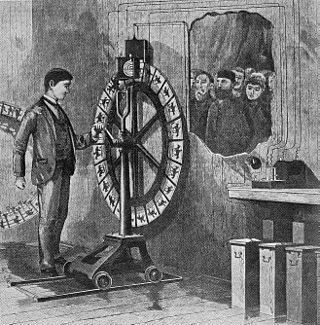
The Elektrischen Schnellseher or Electrotachyscope was an early motion picture system developed by chronophotographer Ottomar Anschütz between 1886 and 1894. He made at least seven different versions of the machine, including a projector, a peep-box viewer and several versions with illuminated glass photographs on a rotating wheel viewed on a 12.5 cm (4.9 in) wide milk glass screen by up to seven people at the same time.
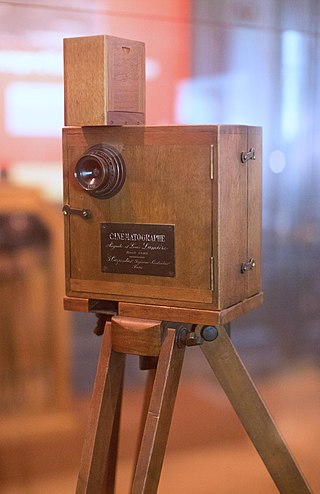
Cinematograph or kinematograph is an early term for several types of motion picture film mechanisms. The name was used for movie cameras as well as film projectors, or for complete systems that also provided means to print films.

Vitascope was an early film projector first demonstrated in 1895 by Charles Francis Jenkins and Thomas Armat. They had made modifications to Jenkins' patented Phantoscope, which cast images via film and electric light onto a wall or screen. The Vitascope is a large electrically-powered projector that uses light to cast images. The images being cast are originally taken by a kinetoscope mechanism onto gelatin film. Using an intermittent mechanism, the film negatives produced up to fifty frames per second. The shutter opens and closes to reveal new images. This device can produce up to 3,000 negatives per minute. With the original Phantoscope and before he partnered with Armat, Jenkins displayed the earliest documented projection of a filmed motion picture in June 1894 in Richmond, Indiana.

L'arrivée d'un train en gare de La Ciotat is an 1895 French short silent documentary film directed and produced by Auguste and Louis Lumière. Contrary to myth, it was not shown at the Lumières' first public film screening on 28 December 1895 in Paris, France: the programme of ten films shown that day makes no mention of it. Its first public showing took place in January 1896. It is indexed as Lumière No. 653.

Actuality film is a non-fiction film genre that uses footage of real events, places, and things, in a similar way to documentary film. Unlike documentaries, actuality films are not structured into a larger narrative or coherent whole. In practice, actuality films preceded the emergence of the documentary. During the era of early cinema, actualities—usually lasting no more than a minute or two and usually assembled together into a program by an exhibitor—were just as popular and prominent as their fictional counterparts. The line between "fact" and "fiction" was not as prominent in early cinema as it would become once documentaries became the predominant non-fiction filmmaking form. Actuality as a film genre is related to still photography.

Robert William Paul was an English pioneer of film and scientific instrument maker.

Cinéorama was an early film experiment and amusement ride presented for the first time at the 1900 Paris Exposition. It was invented by Raoul Grimoin-Sanson and it simulated a ride in a hot air balloon over Paris. It represented a union of the earlier technology of panoramic paintings and the recently invented technology of cinema. It worked by means of a circulatory screen that projects images helped by ten synchronized projectors.
Raoul Grimoin-Sanson (1860–1941) was an inventor in the field of early cinema. He was born in Elbeuf, as Raoul Grimoin; he added the surname Sanson later. He had an early interest in stage magic as well as photography.
The decade of the 1890s in film involved some significant events.

L'Arroseur Arrosé is an 1895 French short black-and-white silent comedy film directed and produced by Louis Lumière and starring François Clerc and Benoît Duval. It was first screened on June 10, 1895.

The Countryman and the Cinematograph is a 1901 British short silent comedy film, directed by Robert W. Paul, featuring a stereotypical yokel reacting to films projected onto a screen. The film "is one of the earliest known examples of a film within a film", where, according to Michael Brooke of BFI Screenonline, "the audience reaction to that film is as important a part of the drama as the content of the film itself".
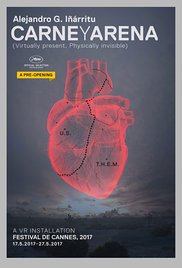
Flesh and Sand is a 2017 American short virtual reality project written and directed by Alejandro González Iñárritu that plunges "viewers into the harsh life of an immigrant". It was created by Iñárritu and cinematographer Emmanuel Lubezki in collaboration with ILMxLAB with support from Legendary Entertainment and the Fondazione Prada in Italy.

Uncle Tom's Cabin is a 1903 American silent short drama directed by Edwin S. Porter and produced by the Edison Manufacturing Company. The film was adapted from the 1852 novel Uncle Tom's Cabin by Harriet Beecher Stowe. The plot streamlined the actual story to portray the film over the course of 19 minutes. The film was released on 3 August 1903 at the Huber's Fourteenth Street Museum in New-York.


















